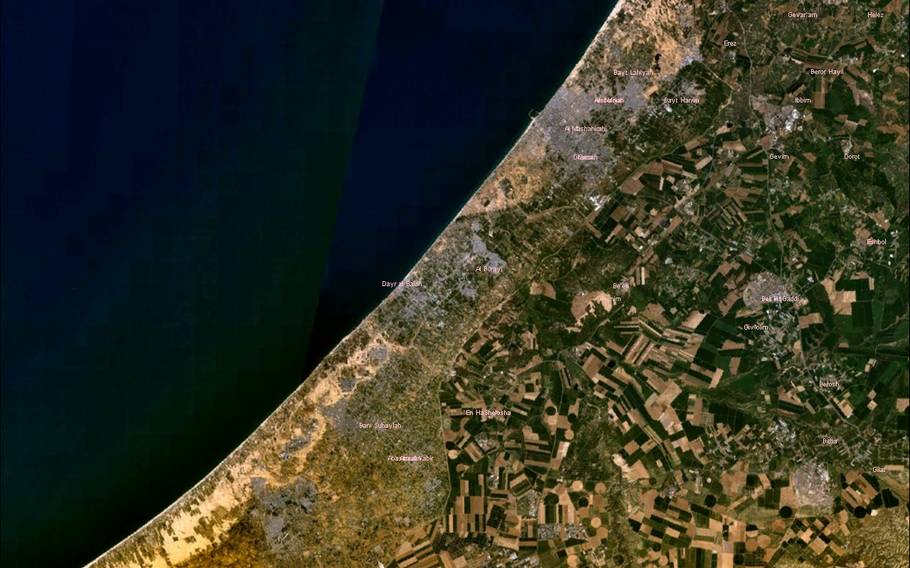
As Israel’s furious retaliation for last weekend’s Hamas attack devastates large swathes of the Gaza strip, killing hundreds and maiming thousands of Palestinians, it is not unreasonable to wonder why the 2.3 million civilians living in the tiny enclave don’t flee to safer ground (NASA/Wikimedia Commons)
(Bloomberg Opinion) -- Why don’t they just leave? As Israel’s furious retaliation for last weekend’s Hamas attack devastates large swathes of the Gaza strip, killing hundreds and maiming thousands of Palestinians, it is not unreasonable to wonder why the 2.3 million civilians living in the tiny enclave don’t flee to safer ground. The question will acquire greater urgency in the days ahead, given the high likelihood of a ground invasion by the Israeli Defense Forces - which will mean days, weeks and even months of grueling street-by-street, house-by-house battles.
The short answer to that question is: They can’t. Before I explain why, consider the lay of the land and the situation in which Gazans find themselves right now.
At 139 square miles, the Gaza Strip is approximately the size of Philadelphia, with a third more people. There is very little open space within the enclave where 2 million people can hunker down and wait for the fighting to end. The siege imposed by Israel is designed, in the words of Defense Minister Yoav Gallant, to leave Gaza with “no electricity, no food, no water, no gas - it’s all closed.”
The Israeli Defense Forces say the bombing campaign that is currently reducing entire Gazan neighborhoods to rubble is targeted at known Hamas hideouts, control centers and weapons caches. But the terrorist group deliberately hides out in densely populated areas, using the large numbers of Palestinians there as human shields. Bombs and rockets - and collapsing buildings - make no distinctions between combatants and civilians.
Many Gazans are being forced out of their homes and neighborhoods, but there’s nowhere safe for them to go.
Under normal circumstances, every human instinct would be to get out of the strip. And you’d expect Gazans to take heart from reports of the US and Egypt discussing so-called humanitarian corridors through which they might be able to escape.
But none of the circumstances prevailing in Gaza is normal, and not just because of the current war. Since Hamas took control of the enclave in 2006, a few months after Israel withdrew its forces from the strip, most of the Palestinians living there have essentially been penned into what human-rights groups call the “world’s largest open-air prison.”
Now, back to the question: Why don’t they just leave?
The first thing to consider is whether they want to. The vast majority of people living in Gaza are already refugees from towns and villages now in Israel and in the West Bank. Although there is little optimism they will return to their ancestral homes, most are keenly aware that the strip is the only place where they can cling to their identity as Palestinians. They fear that if they leave this last patch of homeland, they may not be able to - or allowed to - come back. To become a refugee twice removed is a fate few would welcome.
War shakes convictions and changes priorities, so it is conceivable that many Gazans would now be open to leaving to save their families and themselves from injury or death. Some reports say many are heading southward to the Rafah crossing between Gaza and Egypt.
But that journey is perilous and may be pointless. Not only do the Palestinians fleeing south run the gauntlet of Israeli bombs, but they also risk the wrath of Hamas. The terrorist group has closed the border in the past, and although it handed over control of the crossing to the Palestinian Authority five years ago, its gunmen keep an eye on comings and goings -and are not above exemplary executions to frighten the populace.
Those who brave the risks to get to Rafah can’t be sure of any rewards. The Egyptian authorities have closed their side of the crossing to prevent the Palestinians from breaking out. Although the Biden administration is pressing for it to be reopened, the regime of General Abdel-Fattah El-Sisi is loath to take on the responsibility of hosting thousands of refugees. If this sounds cruel, it is consistent with longstanding policy: Egypt is solicitous about the problems of Palestinians but doesn’t want them on its soil. Cairo is already trotting out its usual excuses of poverty and security: Egypt can’t afford to host refugees, and they might cause trouble.
Other Arab nations offer variations of those lines. Jordan already has too many Palestinians (they make up more than half the population of the kingdom) and too many refugees from other places, such as Syria. Turkey, which is sympathetic to the Palestinian cause, likewise has its hands full of refugees from other parts.
The Gulf Arab states have plenty of land and no shortage of money; Saudi Arabia is currently spending hundreds of billions of dollars building a city it doesn’t really need. Their traditional excuse for not taking in Palestinians is that it would let Israel off the hook.
There are questions to be asked about why Iran, Hamas’s sponsor and self-proclaimed champion of the Palestinians, doesn’t offer to host them. And why the European nations, which wring their hands when Gaza is bombed, can find no place for at least a few of the victims. But by now, you get my point: The civilians in Gaza can’t leave, and it’s a tragedy twice over that nobody wants them anyway. This column does not necessarily reflect the opinion of the editorial board or Bloomberg LP and its owners.
Bobby Ghosh is a Bloomberg Opinion columnist covering culture. Previously, he covered foreign affairs.